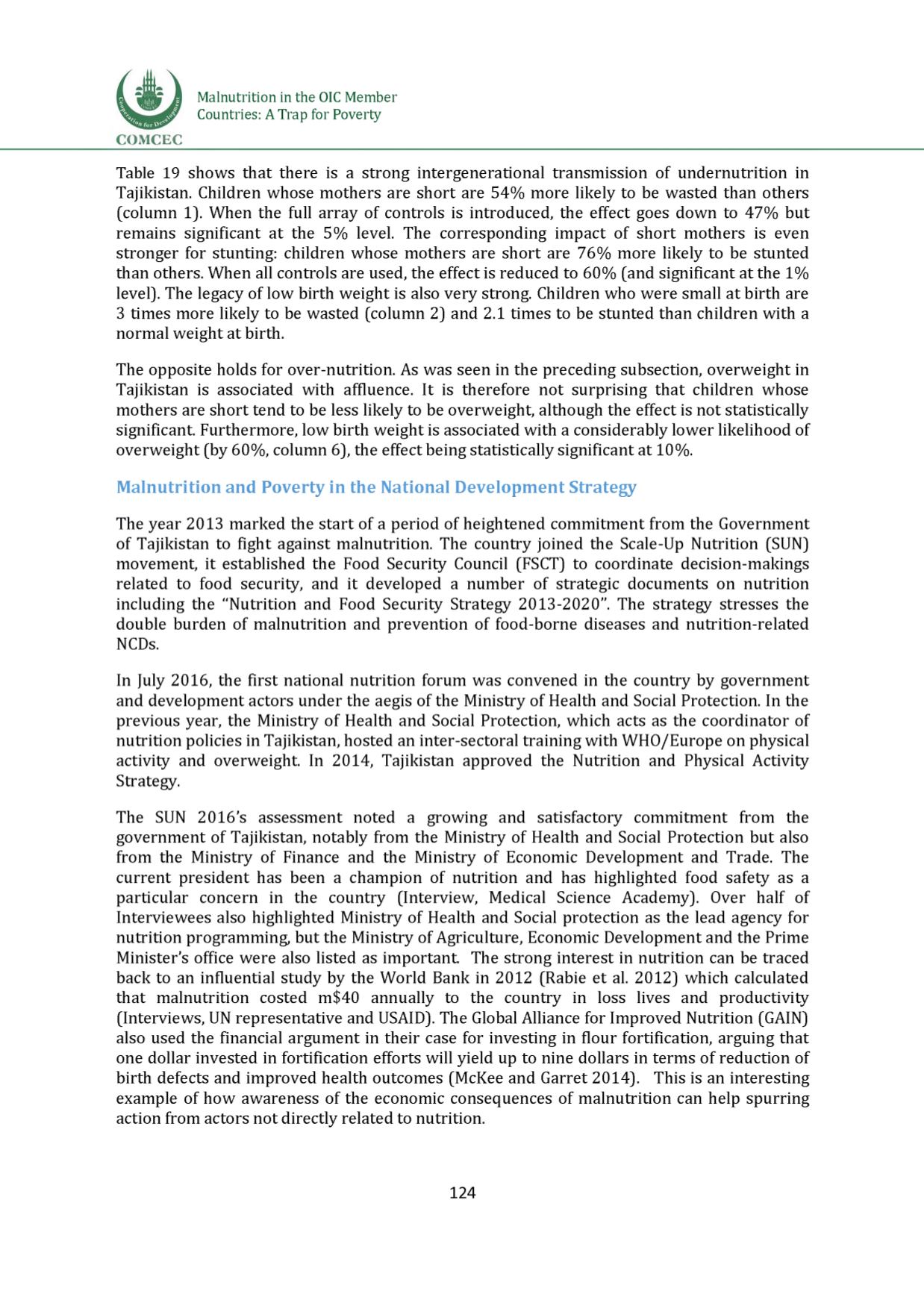

COMCEC
Malnutrition in the OIC Member
Countries: A Trap for Poverty
Table 19 shows that there is a strong intergenerational transmission of undernutrition in
Tajikistan. Children whose mothers are short are 54% more likely to be wasted than others
(column 1). When the full array of controls is introduced, the effect goes down to 47% but
remains significant at the 5% level. The corresponding impact of short mothers is even
stronger for stunting: children whose mothers are short are 76% more likely to be stunted
than others. When all controls are used, the effect is reduced to 60% (and significant at the 1%
level). The legacy of low birth weight is also very strong. Children who were small at birth are
3 times more likely to be wasted (column 2) and 2.1 times to be stunted than children with a
normal weight at birth.
The opposite holds for over-nutrition. As was seen in the preceding subsection, overweight in
Tajikistan is associated with affluence. It is therefore not surprising that children whose
mothers are short tend to be less likely to be overweight, although the effect is not statistically
significant. Furthermore, low birth weight is associated with a considerably lower likelihood of
overweight (by 60%, column
6
), the effect being statistically significant at
1 0
%.
Malnutrition and Poverty in the National Development Strategy
The year 2013 marked the start of a period of heightened commitment from the Government
of Tajikistan to fight against malnutrition. The country joined the Scale-Up Nutrition (SUN)
movement, it established the Food Security Council (FSCT) to coordinate decision-makings
related to food security, and it developed a number of strategic documents on nutrition
including the “Nutrition and Food Security Strategy 2013-2020”. The strategy stresses the
double burden of malnutrition and prevention of food-borne diseases and nutrition-related
NCDs.
In July 2016, the first national nutrition forum was convened in the country by government
and development actors under the aegis of the Ministry of Health and Social Protection. In the
previous year, the Ministry of Health and Social Protection, which acts as the coordinator of
nutrition policies in Tajikistan, hosted an inter-sectoral training with WHO/Europe on physical
activity and overweight. In 2014, Tajikistan approved the Nutrition and Physical Activity
Strategy.
The SUN 2016's assessment noted a growing and satisfactory commitment from the
government of Tajikistan, notably from the Ministry of Health and Social Protection but also
from the Ministry of Finance and the Ministry of Economic Development and Trade. The
current president has been a champion of nutrition and has highlighted food safety as a
particular concern in the country (Interview, Medical Science Academy). Over half of
Interviewees also highlighted Ministry of Health and Social protection as the lead agency for
nutrition programming, but the Ministry of Agriculture, Economic Development and the Prime
Minister's office were also listed as important. The strong interest in nutrition can be traced
back to an influential study by the World Bank in 2012 (Rabie et al. 2012) which calculated
that malnutrition costed m$40 annually to the country in loss lives and productivity
(Interviews, UNrepresentative and USAID). The Global Alliance for Improved Nutrition (GAIN)
also used the financial argument in their case for investing in flour fortification, arguing that
one dollar invested in fortification efforts will yield up to nine dollars in terms of reduction of
birth defects and improved health outcomes (McKee and Garret 2014). This is an interesting
example of how awareness of the economic consequences of malnutrition can help spurring
action from actors not directly related to nutrition.
124
















